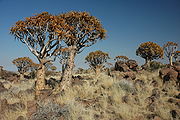
G. W. Reynolds
Encyclopedia

Mbabane
-References:...
), was a South African optometrist and authority on the genus Aloe
Aloe
Aloe , also Aloë, is a genus containing about 500 species of flowering succulent plants. The most common and well known of these is Aloe vera, or "true aloe"....
.
Gilbert Reynolds arrived in Johannesburg
Johannesburg
Johannesburg also known as Jozi, Jo'burg or Egoli, is the largest city in South Africa, by population. Johannesburg is the provincial capital of Gauteng, the wealthiest province in South Africa, having the largest economy of any metropolitan region in Sub-Saharan Africa...
with his parents in 1902, where his father started business as an optician. He received his education at St John's College
St John's College (Johannesburg, South Africa)
St John's College is a private school for boys in Houghton, Johannesburg, Gauteng, South Africa.-History:St John's College was founded in Johannesburg on 1 August 1898 and is an Anglican school....
where he was Victor Ludorum
Victor Ludorum
Victor Ludorum is Latin for "the winner of the games." It is usually a trophy presented to the most successful team, club, or competitor at a sports event. It is common at rowing regattas and was traditional at some British public school sports days...
. After the outbreak of World War I
World War I
World War I , which was predominantly called the World War or the Great War from its occurrence until 1939, and the First World War or World War I thereafter, was a major war centred in Europe that began on 28 July 1914 and lasted until 11 November 1918...
he enlisted and saw active service in South West Africa
South West Africa
South-West Africa was the name that was used for the modern day Republic of Namibia during the earlier eras when the territory was controlled by the German Empire and later by South Africa....
and Nyasaland
Nyasaland
Nyasaland or the Nyasaland Protectorate, was a British protectorate located in Africa, which was established in 1907 when the former British Central Africa Protectorate changed its name. Since 1964, it has been known as Malawi....
with the rank of Captain. Having qualified as optometrist he joined his father's practice in 1921. Reynolds developed a keen interest in the bulbs and succulents of South Africa at about this time. When he started his own country practice about 1930, he was able to travel extensively and gradually narrowed his interests to Aloe
Aloe
Aloe , also Aloë, is a genus containing about 500 species of flowering succulent plants. The most common and well known of these is Aloe vera, or "true aloe"....
.
Reynolds was guided in the early stages of his research by Dr I. C. Verdoorn and Dr R. A. Dyer of the Botanical Research Institute in Pretoria, later becoming the authority on Aloe and having an extensive knowledge of the genus in the field and under cultivation. To gather material for his book, he explored the entire country, collecting specimens, gathering data and taking photographs of the plants in their natural habitats. General Smuts, himself an avid collector and experienced botanist, wrote the foreword to the book. Before the publication of Reynolds' work, no comprehensive guide to the aloes had been compiled, except for various writings and monographs which did not attempt a complete coverage.
He spent four weeks at Kew
Royal Botanic Gardens, Kew
The Royal Botanic Gardens, Kew, usually referred to as Kew Gardens, is 121 hectares of gardens and botanical glasshouses between Richmond and Kew in southwest London, England. "The Royal Botanic Gardens, Kew" and the brand name "Kew" are also used as umbrella terms for the institution that runs...
towards the end of 1960, checking the taxonomy, type specimens and identifications.
Publications
- The Aloes of South Africa - G.W. Reynolds (Johannesburg, 1950)
- Les Aloes de Madagascar - G.W. Reynolds (Tananarive, 1958)
- The Aloes of Tropical Africa and Madagascar - G.W. Reynolds (Cape Town, 1966)
He published numerous popular articles in African Wild Life detailing his collecting trips to places as far afield as Somaliland
Somaliland
Somaliland is an unrecognised self-declared sovereign state that is internationally recognised as an autonomous region of Somalia. The government of Somaliland regards itself as the successor state to the British Somaliland protectorate, which was independent for a few days in 1960 as the State of...
, Eritrea
Eritrea
Eritrea , officially the State of Eritrea, is a country in the Horn of Africa. Eritrea derives it's name from the Greek word Erethria, meaning 'red land'. The capital is Asmara. It is bordered by Sudan in the west, Ethiopia in the south, and Djibouti in the southeast...
, Ethiopia
Ethiopia
Ethiopia , officially known as the Federal Democratic Republic of Ethiopia, is a country located in the Horn of Africa. It is the second-most populous nation in Africa, with over 82 million inhabitants, and the tenth-largest by area, occupying 1,100,000 km2...
and Madagascar
Madagascar
The Republic of Madagascar is an island country located in the Indian Ocean off the southeastern coast of Africa...
, as well as many scientific papers in botanical journals on the subject of aloes. After his death, his collection of aloes was transplanted to the Mlilwane Game Sanctuary in Swaziland
Swaziland
Swaziland, officially the Kingdom of Swaziland , and sometimes called Ngwane or Swatini, is a landlocked country in Southern Africa, bordered to the north, south and west by South Africa, and to the east by Mozambique...
, with quite a number going to the National Botanical Institute in Pretoria.

